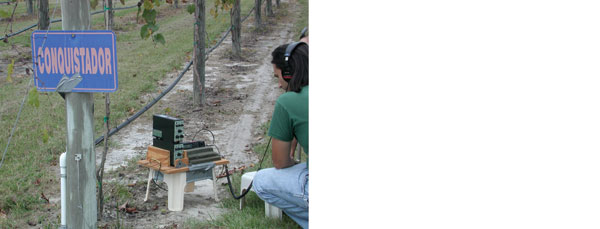Extracts

Acoustic Monitors Could Help Grape Growers Thrive
By Mickie Anderson
Help may be on the way for grape growers in the southeast battling a crop-devouring pest called the grape root borer.
The grape root borer, a wasp-looking moth, lays its eggs on the leaves of grapevines along the east coast from Virginia to Florida. When the eggs hatch, hungry little larvae drop to the ground, tunnel down to the plant’s roots and devour major portions of the plant’s root system — depriving the vine of the nourishment it needs to thrive.
Once the larvae have eaten their fill, they burrow back to the surface, transform into their adult moth form and begin the cycle anew by laying eggs on the leaves.
Growers have few defenses against the pest. The only pesticide known to be effective against the moth is also toxic to birds, fish and bees. And mounding — piling up dirt near the base of the plant stem to stop an infestation — is labor intensive.
But what if you could tell exactly where the moth larvae were feasting?
UF researchers recently tested a device previously used to detect pests in grain silos to see if it could also help grape growers in their battle against the root borer. The device, called an accelerometer, “listens” for telltale sounds of munching and crunching underground.
After testing the device in vineyards in Florahome and Lithia, Florida, the researchers determined that the device could not tell a root borer from other subterranean insects. However, it could be used to determine which areas were pest-free, and that could reduce the number of plants that require mounding by as much as 75% — a substantial savings in time and money for growers in the southeast.